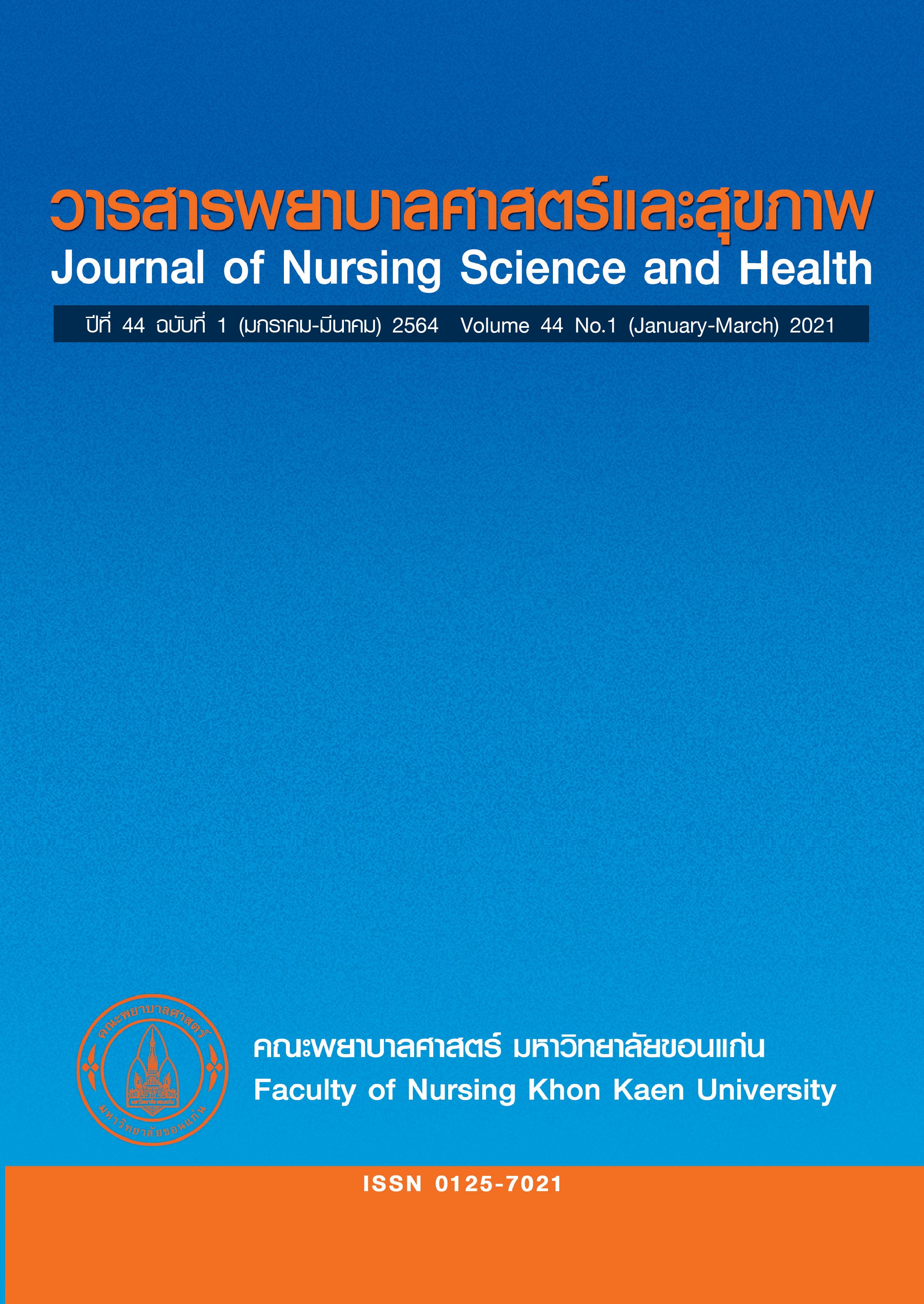ความสัมพันธ์ของปัจจัยที่มีผลต่อการเกิดภาวะเลือดออกใต้ผิวหนังชนิดมีก้อนที่ขาหนีบหลังสวนหัวใจในผู้ป่วยวิกฤตหัวใจ
คำสำคัญ:
ปัจจัยเสี่ยงของการเกิดเลือดออกใต้ผิวหนังชนิดมีก้อน, ก้อนเลือดที่หลอดเลือดขาหนีบ, หลังการสวนหัวใจบทคัดย่อ
การวิจัยเชิงบรรยายแบบศึกษาข้อมูลย้อนหลังนี้มีวัตถุประสงค์เพื่อศึกษาความสัมพันธ์ของปัจจัยที่มีผล ต่อการเกิดภาวะแทรกซ้อนเลือดออกชั้นใต้ผิวหนังชนิดมีก้อนหลังดึงท่อนำสายสวนหัวใจที่ขาหนีบออกในผู้ป่วย ภาวะหัวใจขาดเลือดเฉียบพลัน ในหอผู้ป่วยวิกฤตหัวใจ 65 ราย คัดเลือกกลุ่มตัวอย่างแบบเฉพาะเจาะจงตาม เกณฑ์คัดเข้า เก็บข้อมูลโดยใช้แบบบันทึกการปฏิบัติขณะมีสายและหลังนำสายสวนหัวใจออก (CCU’s off sheath form version7) ระหว่างวันที่ 1 มกราคม ถึง 31 ธันวาคม พ.ศ. 2558 วิเคราะห์ข้อมูลด้วยสถิติเชิงบรรยาย สถิติไคสแควร์ และ binary logistic regression
ผลการศึกษาพบว่าปัจจัยส่วนบุคคลไม่มีความสัมพันธ์กับการเกิดภาวะแทรกซ้อนเลือดออกชั้นใต้ผิวหนังชนิดมีก้อน (p>.05) ส่วนปัจจัยด้านการรักษา ได้แก่ การกดห้ามเลือดด้วยมือและเครื่องกดมีความสัมพันธ์กับการเกิดภาวะแทรกซ้อนเลือดออกชั้นใต้ผิวหนังชนิดมีก้อน (p<.05) โดยการกดห้ามเลือดด้วยมือ 10-14 นาที เปรียบเทียบกับกลุ่ม 15-20 นาที พบว่า การกดด้วยมือ 10-14 นาที ป้องกันการเกิดเลือดออกชั้นใต้ผิวหนังชนิดมีก้อนได้ 0.04 เท่า (95% CI, 0.00-0.38; P =0.00) และการกดห้ามเลือดต่อด้วยเครื่องมือเพิ่มความเสี่ยงต่อการเกิดเลือดออกชั้นใต้ผิวหนังมากกว่าถึง 6.27 เท่า (95% CI, 1.03-38.18; P=0.04) เมื่อเทียบกับไม่ใช้เครื่องกด ผลการศึกษานี้มีประโยชน์ในการเน้นการประเมินการกดห้ามเลือดทั้งด้วยมือ และเครื่องกดที่ถูกวิธีเพื่อป้องกันการเกิดภาวะแทรกซ้อนที่จะเกิดขึ้น
เอกสารอ้างอิง
Ministry of Public Health, Bureau of Non Communicble Disease. World heart day campaign; 2018 [cited 2018 August 18]. Available from: http://thaincd.com/document/ file/download/knowledge/81_61.pdf. (in Thai)
Department of disease control. Ministry of public health. Coronary artery disease (CAD) 2019 [cited 2020 August 5]. Available from: https://ddc.moph.go.th/uploads/files/108112 0191227091554.pdf. (in Thai)
Public health statistics. Health information unit, strategy and planning division. 2018 [cited 2020 August 5]. Available from: https://bps.moph.go.th/ new_bps/ sites/default/ files/statistic% 2061.pdf. (in Thai)
Chomnapas W. Acute myocardial infarction and the lower of mortality; 2019 [cited 2020 August 15]. Available from: https://www. thaihealth.or.th/Content/49818. (in Thai)
Roffi M, Patrono C, Collet JP, Mueller C, Valgimigli M, Andreotti F, et al. 2015 ESC guidelines for the management of acute coronary syndromes in patients presenting without persistent ST-segment elevation. Eur Heart J 2016;37:267-315.
Odom BS. Management of patients after percutaneous coronary interventions. Crit Care Nurse 2008;28(5):1-16.
Wong EM, Wu EB, Chan WW, Yu CM. A review of the management of patients after percutaneous coronary intervention. Int J Clin Pract 2006;60(5):582-9.
Ausawakijpanich S, Duangbubpha S, Nantasukhon A. The effects of self care agency promoting program on self- care confidence and groin wound complications in patients post cardiac catheterization. Rama Nurs J 2019;25(2): 148-65. (in Thai)
Mrdovic I, Savic L, Krljanac G, Asanin M, Lasica R, Djuricic N, et al. Simple risk algorithm to predict serious bleeding in patients with ST-segment elevation myocardial infarction undergoing primary percutaneous coronary intervention. Circ J 2013;77:1719-27.
Sulzbach-Hoke LM, Ratcliffe SJ, Kimmel SE, Kolansky DM, Polomano R. Predictors of complications following sheath removal with percutaneous coronary intervention. J Cardiovasc Nurs 2010;25(3):1-8.
Paganin AC, Beghetto MG, Feijo MK, Matte R, Sauer JM, Rabelo-Silva ER, et al. Vascular complications in patients who underwent endovascular cardiac procedures: multicenter cohort study. Rev. Latino-Am. Enfermagem 2018;26:1-7.
Kassem HH, Elmahdy MF, Ewis EB, Mahdy SG. Incidence and predictors of post-catheterization femoral artery pseudoaneurysms. Egypt Heart J 2013;65:231-21.
Robert JA, Matthew TS, Michael AK, Frederic RK, Sanjay KG, Renato MS, et al. Trends in vascular complications after diagnostic cardiac catheterization and percutaneous coronary intervention via the femoral artery, 1998 to 2007. JACC Cardiovasc Interv 2008; 1(3):317-26.
Numasawa Y, Kohsaka S, Ueda I, Miyata H, Sawano M, Kawamura A, et al. Incidence and predictors of bleeding complications after percutaneous coronary intervention. J Cardiol 2017;69:272–9.
Tavakol M, Ashraf S, Brener SR. Risks and complications of coronary angiography: A comprehensive review. Glob J Health Sci 2012;4(1):65-93.
Suggs PM, Reagan SR, Clements FC, Hardin SR. Factors associated with groin complications post coronary intervention. Clin Nurs Stud 2013; 1(1): 26-34. Available from: http://dx. doi. org/10.5430/cns.v1n1p26
Heywood C, Huang M, Bober W, Raio C. Ultrasound-assisted compression of the femoral artery in a hypotensive patient with expanding hematoma post cardiac catheterization. J Intern Emerg Med 2018;2(2):1-3.
Fong SS, Jaafar S, Misra S, Narasimha V. Scrotal hematoma with pseudo-aneurysm after transfemoral catheterization. J Surg Case Rep 2019;2:1–4.
Lins S, Guffey D, VanRiper S, Kline-Rogers E. Decreasing vascular complications after percutaneous coronary interventions. Crit Care Nurse 2006;26(6):38-46.
Merriweather N, Sulzbach-Hoke LM. Managing risk of complications at femoral vascular access sites in percutaneous coronary intervention. Crit Care Nurse 2012;32(5):1-14.
Batiha AM, Abu-Shaikha HS, Alhalaiqa FN, Jarrad AR, Ramadan JH. Predictors of complications after sheath removal post transfemoral percutaneous coronary interventions. Open J Nurs 2016;6:497-504.
Ebeed MS, Khali NS, Ismaeel MS. Vascular complications and risk factors among patients undergoing cardiac catheterization. Egypt Heart J 2017;14:259–68.
Suggs PM, Reagan SR, Clements FC, Hardin SR. Factors associated with groin complications post coronary intervention. J Clin Nurs 2013;1(1):26-34.
Dandecha B, Chalernsin C. A comparison of efficiency and safety of femoral artery hemostasis after coronary angiography between manual compression and mechanical compression. J Health Sci Med Res 2011;29(2):51-6. (in Thai)
Amoroso G. Why cardiology nurses should worry about vascular complications and arterial access. Eur J Cardiovasc Nurs 2006; 5(3-4):1-2.
Yaman P. Evidence based practice, percutaneous coronary intervention (PCI); 2013 [cited 2016 July 15]. Available from: http://www.hospital. tu.ac.th/doc/EO/261155-1.pdf. (in Thai)
Krejcie VR, Morgan WD. Determining sample size for research activity. Educ Psychol Meas 1970;30:607-10.
Schulz-Schupke S, Helde S, Gewalt S, Ibrahim T, Linhardt M, Haas K, et al. Comparison of vascular closure devices vs manual compression after femoral artery puncture: the ISAR-CLOSURE randomized clinical trial. JAMA 2014;312(19):1981- 7.
Hassan AKM, Hasan-Ali H, Ahmed SA. A new femoral compression device compared with manual compression for bleeding control after coronary diagnostic catheterizations. Egypt Heart J 2014;66:233-9.
ดาวน์โหลด
เผยแพร่แล้ว
รูปแบบการอ้างอิง
ฉบับ
ประเภทบทความ
สัญญาอนุญาต
วารสารพยาบาลศาสตร์และสุขภาพเป็นเจ้าของลิขสิทธิ์ในการเผยแพร่ผลงานที่ตีพิมพ์ห้ามผู้ใดนำบทความที่ได้รับการตีพิมพ์ในวารสารพยาบาลศาสตร์และสุขภาพไปเผยแพร่ในลักษณะต่าง ๆ ดังนี้ การนำบทความไปเผยแพร่ออนไลน์ การถ่ายเอกสารบทความเพื่อกิจกรรมที่ไม่ใช่การเรียนการสอน การส่งบทความไปตีพิมพ์เผยแพร่ที่อื่น ยกเว้นเสียแต่ได้รับอนุญาตจากวารสารพยาบาลศาสตร์และสุขภาพ



